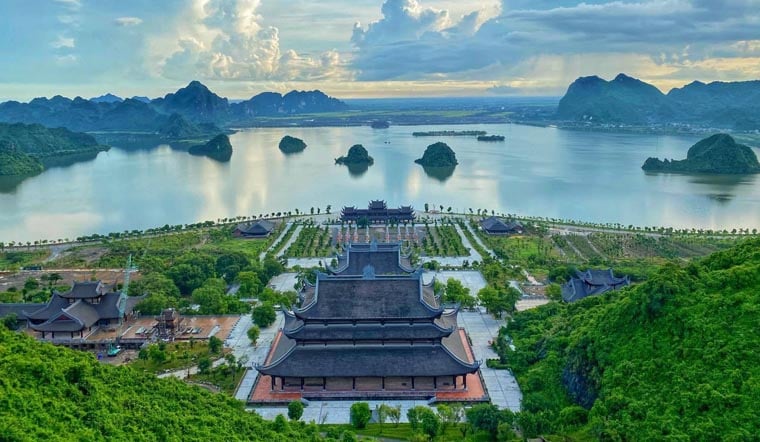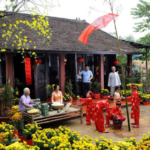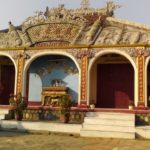Tam Chuc Pagoda – Where is it and whom does it worship?
Tam Chuc Pagoda – Ha Nam is located in Ba Sao town, Kim Bang district, Ha Nam province. It is considered the largest pagoda in the world to date and is part of the Tam Chuc scenic and poetic tourist area.
Tam Chuc Pagoda worships the Master Masters, Zen Master Nguyen Minh Khong, Zen Master Khuong Viet, Venerable Thich Thanh Tu, Zen Master Do Phap Thuan… They are the national masters who have contributed to the development of Vietnamese Buddhism.
Tam Chuc Pagoda is built next to the ancient pagoda of the same name.
Legend has it that in the past, this area was covered with dense forests, with 99 peaks on the mountain range, located in the southwestern direction towards Huong Tich cave (Huong Pagoda), of which 7 peaks are near Tam Chuc village.
The Tam Chuc pagoda complex has a total area of about 5,100 hectares, including a 1,000-hectare lake, a 3,000-hectare rocky mountain and natural forest, and nearly 1,000 hectares of valleys. Currently, Tam Chuc pagoda is considered the largest pagoda in the world up to the present time.
Tam Chuc Pagoda was built next to the ancient pagoda of the same name. According to historical records, the ancient Tam Chuc pagoda was built during the Dinh dynasty and is closely associated with the legend: “Front six notes – back seven notes”.

When is the best time to visit Tam Chuc Pagoda, Ha Nam?
The ideal time to visit Tam Chuc Pagoda, Ha Nam is in the spring, specifically the early months of the year, during the festival season from the 10th day of the Lunar New Year to the end of the third Lunar month. The weather is cool, and visitors can participate in praying for wealth and luck.
Depending on the purpose of the trip, if you just want to explore Tam Chuc Pagoda, enjoy the beautiful scenery, and the solemnity of the Buddhist site, you can visit Tam Chuc Pagoda in any season.
Transportation to Tam Chuc Pagoda, Ha Nam
There are many ways to travel to Tam Chuc Pagoda, Ha Nam, and you can choose different modes of transportation for your convenience:
Bus: Visitors in Hanoi can choose the Hanoi – Phu Ly bus route, starting from Giap Bat bus station.
Coach: This is a convenient means of transportation to Tam Chuc Pagoda. Most coaches run on the Phap Van – Gie Bridge expressway, which is very fast, and it only takes 1 hour to reach the destination.
Private vehicle: You can choose to travel to Tam Chuc Pagoda by motorbike or private car. If you start from Hanoi, you can drive along National Highway 1A across Gie Bridge and continue straight to the pagoda.

Are there any other famous pagodas in Ha Nam?
Ba Danh Pagoda is located in Danh village, Ngoc Son commune, Kim Bang district, Ha Nam province, about 7km from the center of Phu Ly city in the southwest direction along National Highway 21B. This place is considered one of the most beautiful and ancient pagodas in Ha Nam and the Northern region in general.
According to the local legend, the pagoda is a sacred place where people worship the goddess who controls the rain and wind, helping people to avoid floods and bring about harmony between rain and wind, resulting in abundant crops. Therefore, it is called Ba Danh Pagoda.
If in the past, the saying “as deserted as Ba Danh Pagoda” was famous, now Ba Danh Pagoda attracts many domestic and foreign tourists to visit and worship.
According to the provincial electronic information portal, Ha Nam province has an area of over 860 km2, the second smallest in Vietnam, slightly larger than Bac Ninh with an area of 832 km2.
In terms of geographical location, Ha Nam is located in the Red River Delta. It borders Hung Yen and Thai Binh provinces to the East, Nam Dinh and Ninh Binh provinces to the South, Hoa Binh province to the West, and Hanoi to the North. It is only 50-60km from the center of Hanoi, making Ha Nam the gateway to the capital.

How much is the ticket to Tam Chuc, Ha Nam tourist area?
The question of how much the ticket to Tam Chuc Pagoda, Ha Nam is interests many tourists. In fact, tourists do not have to pay an entrance fee to visit the pagoda, but they need to choose one of two means of transportation, electric cars or boats, for sightseeing:
Electric car: The ticket price is about 90,000 VND/round-trip/ticket, which allows visitors to take a road along the shores of Luc Nhac Lake to the inner area of the pagoda.
Boat: The ticket price is about 200,000 – 350,000 VND/person, from the boat dock to the main gate, and then to other sightseeing spots.
There are also many other transportation and dining combos. Visitors should note that the above prices are for reference only and may vary depending on the actual circumstances and occasions. Before visiting, tourists should contact the pagoda directly to update the latest prices according to the time/occasion.
Travel tips for Tam Chuc Pagoda, Ha Nam
The Tam Chuc tourist area is very large, so you need to carefully refer to the Tam Chuc pagoda map to avoid wasting time finding directions.
If you choose to visit Tam Chuc Pagoda, Ha Nam on festival days, the most ideal means of transportation is motorcycle taxi (xe om). Boat or electric car rides will have long wait times.
As Tam Chuc Pagoda is a spiritual tourist destination, visitors should choose modest and comfortable clothing.
As there is a lot of walking involved in visiting Tam Chuc Pagoda, Ha Nam, visitors should wear comfortable sports shoes.
Attention to tourists visiting Tam Chuc Pagoda, Ha Nam: when entering the temples, it is advised to use the side doors, not the main doors in the middle, and do not step on the sill, but step over it.
Regarding worshiping at Tam Chuc Pagoda, visitors should only light incense at the outside altar, and should limit lighting incense inside the pagoda to avoid affecting the Buddha statues and sacred objects. Only light one incense stick in the incense bowl and do not place incense randomly on the Buddha’s hand, the base of a tree, or the offering table.
Which famous writer is from Ha Nam province?
Nam Cao (? – 1951) was an exemplary writer and poet of the 20th century. He was born in Hoa Hau commune, Ly Nhan district. He was born into a farmer’s family in Dai Hoang village, now part of Hoa Hau commune, Ly Nhan district, Ha Nam province. Nam Cao is an outstanding writer of realistic literature (1940-1945).
His famous work “Chi Pheo” was also inspired by the real places and people in Dai Hoang village, Cao Da commune, Nam Sang district, Ly Nhan province; now it is Nhan Hao village, Hoa Hau commune, Ly Nhan district, Ha Nam province.
Nam Cao was posthumously awarded the Ho Chi Minh Prize for Literature and Art in 1996. His representative works include “Bright Moon” (1943), “Surplus Life” (1943), “Worm-Eaten Life” (1944), “Chi Pheo” (1941), “Lao Hac” (1943), “A Full Meal” (1943), etc.
When it comes to Ha Nam specialties, Vũ Đại village braised fish is a must-try dish for tourists. This specialty dish also has other names such as Dai Hoang braised fish, Nhan Hao braised fish, or Ha Nam braised fish. Vũ Đại village braised fish uses black carp, pork belly as the main ingredients, and is seasoned with rural spices.
The process of making and braising fish is very meticulous and time-consuming. However, the finished dish is a pot of delicious braised fish with firm flesh, tender and completely brown fish bones, which is visually appealing. The distinctive taste of Vũ Đại village braised fish makes it a popular choice for both domestic and international diners.
Explore 12 Amazing Destinations for Biking Trips
Unlock Vietnam in a brand new way with an exciting biking tour! Discover the stunning beauty of the country with Dien May XANH’s top 12 must-see destinations. From sweeping plains to clear blue beaches and mountainous vistas – experience all the sights with your own personal cycling tour. Find your ideal route and set out for an adventure today!






































